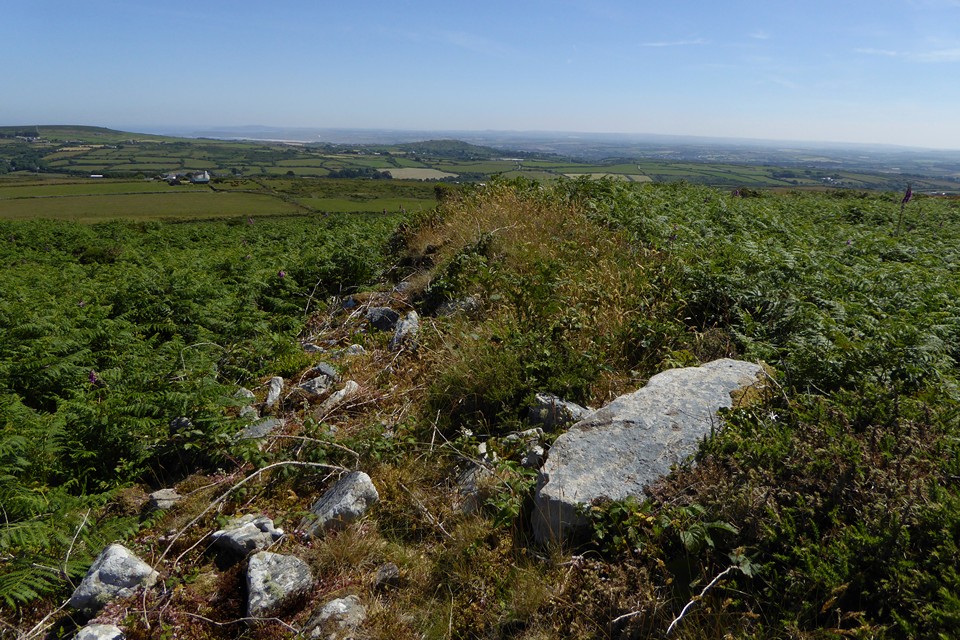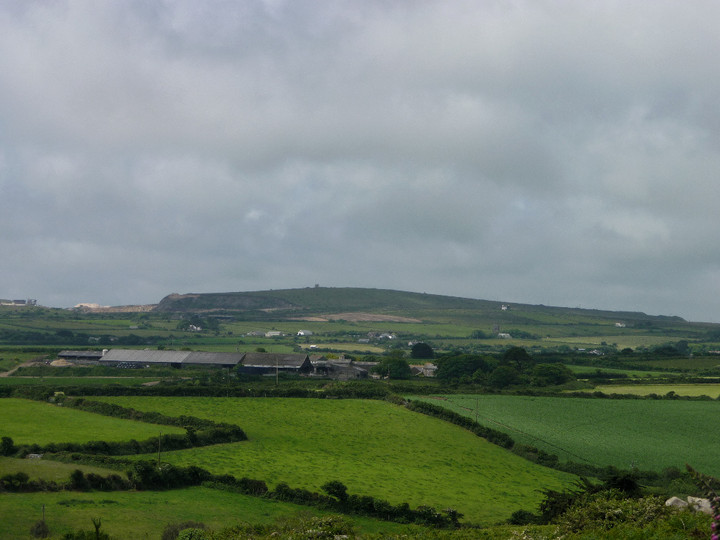
Northeastern rampart.

Northeastern rampart.

Multiple lines of defences on the eastern side of the fort. Looking towards Penzance and Newlyn. The Castle an Dinas quarry keeps going, rather close to the fort.

Roger’s Tower like a giant’s sandcastle. Looking towards the Lizard and St Michael’s Mount.

Well-preserved stonework of the inner rampart on the south side of the fort.

Looking down on the overgrown outer ramparts on the northeastern side of the fort. Hillforts on the distant skyline include Carn Brea (left of centre) and Castle Pencaire (far right).

The northern entrance, looking east. Trencrom is in shadow straight ahead. Over on the left is the white sands of Hayle estuary and Godrevy, beyond that is St Agnes Head and the north coast of Cornwall.

Impressive height still in the northern ramparts.

The western rampart, looking down on the quarry and out across West Penwith.


Looking north towards Trendrine Hill and Rosewall Hill, both with Bronze Age cairns on their summits.

Stonework of the northeastern rampart.

The views stretch across to Castle Pencaire and St Michael’s Mount.

Roger’s Tower folly, built onto (and out of) the inner rampart of the fort.

The southeastern ramparts, with Trencrom Hill prominent to the right of centre.

Overgrown hut circle inside the fort.

The northern ramparts, looking towards Trink Hill.

Viewed from the neighbouring hillfort of Trencrom.

Castle-an-Dinas in its landscape context, looking south-east across Mounts Bay to St Michaels Mount

Another section of the rampart, showing the rubble construction (very like Chun Castle)

The rampart (approaching the fort from the bridleway to the west)

Castle-an-Dinas from the pathway up to it.

The western entrance.

This broken, holed? stone aligns on both of the barrow like structures on the distant hills.

The southern inner and outer banks and ditch.

The northern inner embankment.

What appears to be an internal dividing bank. The building is a folly, probably built out stones robbed from the fort.
This is a substantial hillfort, the banks of which are constructed from granite boulders. The construction is similar to others in the area but is considerably bigger than say, Chun castle. Also it appears to be formed of two concentric rings of ramparts and ditches (apparently there were four)
Within the interior is a dividing bank next to which is a stone built castle-like folly. The folly appears to built from stones robbed from the structure of the ramparts, they seem to be of similar size and there is a gap in the bank next to it.
The only obvious entance I could see was on the west side, there is a stagger in the ramparts here.
I got here by using a footpath about half a mile along the road from Chysauster. It’s not a very steep climb but was very wet and muddy after 24 hours of heavy rain. I was the only person there in the hour or so I was here.
Someone getting a bit of mileage out of the local folklore:
A Singular Legend.
Those prone to superstition, no less than students of folklore, will have a special interest in the finding of the body of the young man who is accused of having murdered his sweetheart on the lofty Cornish hill of Castle an Dinas. The ancient and ruined fortress stands in the parish of Ludgvan; and of the saint after whom it was named there has long been told in the district a singular legend.
Saint Ludgvan, the alleged founder of the church there, was an Irish missionary; and it is said of him that he brought a stream of water under the church stile for the purpose of bestowing on it certain miraculous qualities, one of which was that no person baptised with it should ever expiate any of his crimes through medium of a halter.
Consequently it has been accustomed to be believed that no man of Ludgvan ever suffers this disgrace; and the popular belief in the legend is certain to be strengthened by the fact that now a peculiarly cruel murder has been perpetrated at Castle an Dinas, suicide, to use the old phrase, has “cheated the gallows.”
The belief, it may be added, is so strong in the district that the inhabitants of neighbouring parishes have been known to carry away the water of Ludgvan for baptismal purposes; but proof of its efficacy when thus removed is wanting.
From the (geographically surprising) ‘East of Fife Record’, 24th June 1904. It’s a slightly peculiar interpretation that St Ludgvan would be complicit in people getting away with terrible crimes, perhaps he intended that the local people would actually turn out very good and not do anything meriting hanging. But there we are. The poor victim found in the ditches at Castle-an-Dinas was Jessie Rickard, shot by Charles Berryman.
..Wild Harris of Kenegie {a gentleman’s seat in the parish of Gulval, near Penzance} who was killed when hunting by a fall from his horse-- it was frightened by a white hare, the spirit of a deserted maiden, which crossed its path. His ghost, in his hunting-dress, appeared standing at the door of his house the night he was buried – the funeral, according to an old custom, had taken place at midnight. For years after he might be met in the vicinity of his home, and he and his boon companions were often heard carousing at nights in a summer-house on the bowling-green. Few then cared to pass Kenegie after dark, for his was said not to be the only spirit that haunted the place. Wild Harris’s ghost was finally laid to rest by a famous ghost-laying parson, and put as a task to count the blades of grass nine times in an enclosure on the top of Castle-an-Dinas, an old earth fortification near, where he is said to have met his death.
p 105 in
Cornish Folk-Lore. Part II [Continued]
M. A. Courtney
The Folk-Lore Journal, Vol. 5, No. 2. (1887), pp. 85-112.
Mentioned by Craig Weatherhill, in “Cornovia: Ancient Sites of Cornwall & Scilly” (Cornwall Books – 1985, revised 1997 & 2000) – “133m in diameter, this Iron Age fort consisted of four concentric lines of defence. The inner most, a stonewall, has almost vanished, leaving little more than foundations. The next is another thick wall, tumbled but still 1.8m high in places. It is interrupted on the south-east side by a late eighteenth-century folly, Roger’s Tower, built of stone from the castle walls. The third defence is a strong earth and stone bank; the outermost, another strong rampart of earth, reaches 2.3m in height, but exists only around the north-western half of the fort. Traces of an outer ditch can be see, but the position of the original entrance is not known. In the centre of the fort are three circular structures which, in the light of discoveries at Caer Bran, may either be Iron Age round houses or Bronze Age ring cairns.”
NB – Not to be confused with the other Castle-an-Dinas Hill Fort in the Restormel district of Cornwall.
























































































































































































